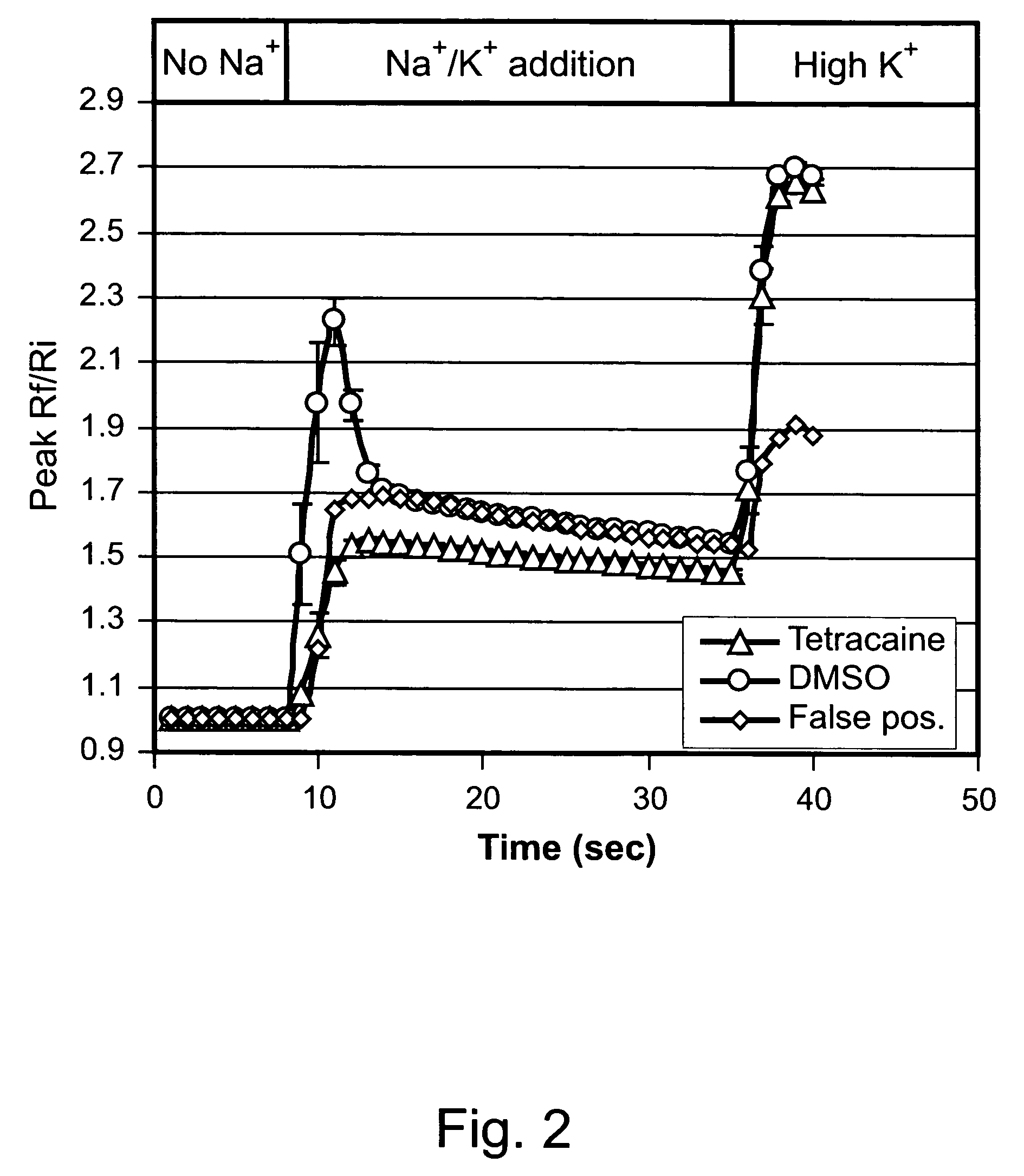Treating pain using selective antagonists of persistent sodium current
a sodium current and selective technology, applied in the field of neurobiology, physiology, biochemistry and medicine, can solve the problems of emesis, nausea, dizziness, and sedation of current therapies, and achieve the effects of reducing the risk of side effects, reducing the effect of current therapy, and improving the effect of pain
- Summary
- Abstract
- Description
- Claims
- Application Information
AI Technical Summary
Benefits of technology
Problems solved by technology
Method used
Image
Examples
example 1
High-throughput Screening Assay for Identification of Inhibitors of Persistent Sodium Current
[0218]To identify compounds that inhibit persistent sodium current, a primary high-throughput screen was employed, see, e.g., Joseph S. Adorante et al., High-throughput Screen for Identifying Channel Blockers that Selectively Distinguish Transient from Persistent Sodium Channels, U.S. Patent Publication No. 2002 / 0077297 (Jun. 20, 2002), which is hereby incorporated by reference in its entirety.
[0219]I. Compound Identification Assay Overview
[0220]To examine the ability of test compounds to alter persistent sodium current, human embryonic kidney (HEK) cells were transfected with Nav1.3 sodium channel to obtain cells that express sodium current capable of mediating persistent sodium current. HEK cells expressing Nav1.3 (HEK-Nav1.3) were added to assay plate wells containing a Na+-free media and physiologic concentrations of K+ (4.5 mM) and preincubated for 20 minutes with ion-sensitive FRET dye...
example 2
Moderate—Throughput Screening Assay for Selectivity of Inhibitors of Persistent Sodium Current
[0246]Compounds obtained by the high-throughput screening described in Example 1 were tested for selectivity of blockade of persistent sodium current with respect to blockade of transient sodium current using a moderate-throughput screen. The selectivity assay utilizes Estim technology (Aurora Bioscience, San Diego, Calif.) to induce channel activation. This assay has an inherently greater time resolution than the high-throughput assay, and thus allows the measurement of both the transient and persistent components of the Na+ currents within a single experiment.
[0247]I. Compound Selectivity Assay Overview
[0248]The Estim technology involves instrumenting 96-well plates with electrodes so that application of an appropriate voltage gradient across the well (electric field stimulation, EFS) can be used for activation of the ion channels in the target cells. EFS of HEK-293 cells expressing Nav1....
example 3
Electrophysiological Assay for Selectivity of Inhibitors of Persistent Sodium Current
[0263]To confirm the blocking selectivity of test compounds for persistent sodium current, individual compounds were examined using a whole-cell patch clamp method.
[0264]HEK cells transfected with Nav1.3 sodium channels that express transient and persistent sodium currents were plated onto glass coverslips and cultured in MEM cell culture media with Earle's salts and GlutaMAX (Invitrogen, Inc., Carlsbad, Calif.) supplemented with: 10% Fetal bovine serum, heat inactivated (Invitrogen, Inc., Carlsbad, Calif.), 0.1 mM MEM non-essential amino acids (Invitrogen, Inc., Carlsbad, Calif.), 10 mM HEPES (Invitrogen, Inc., Carlsbad, Calif.), 1% Penicillin / Streptomycin (Invitrogen, Inc., Carlsbad, Calif.).
[0265]After an incubation period of from 24 to 48 hours the culture medium was removed and replaced with external recording solution (see below). Whole cell patch clamp experiments were performed using an EPC1...
PUM
| Property | Measurement | Unit |
|---|---|---|
| negative membrane potentials | aaaaa | aaaaa |
| membrane potentials | aaaaa | aaaaa |
| voltage | aaaaa | aaaaa |
Abstract
Description
Claims
Application Information
 Login to View More
Login to View More - R&D
- Intellectual Property
- Life Sciences
- Materials
- Tech Scout
- Unparalleled Data Quality
- Higher Quality Content
- 60% Fewer Hallucinations
Browse by: Latest US Patents, China's latest patents, Technical Efficacy Thesaurus, Application Domain, Technology Topic, Popular Technical Reports.
© 2025 PatSnap. All rights reserved.Legal|Privacy policy|Modern Slavery Act Transparency Statement|Sitemap|About US| Contact US: help@patsnap.com



